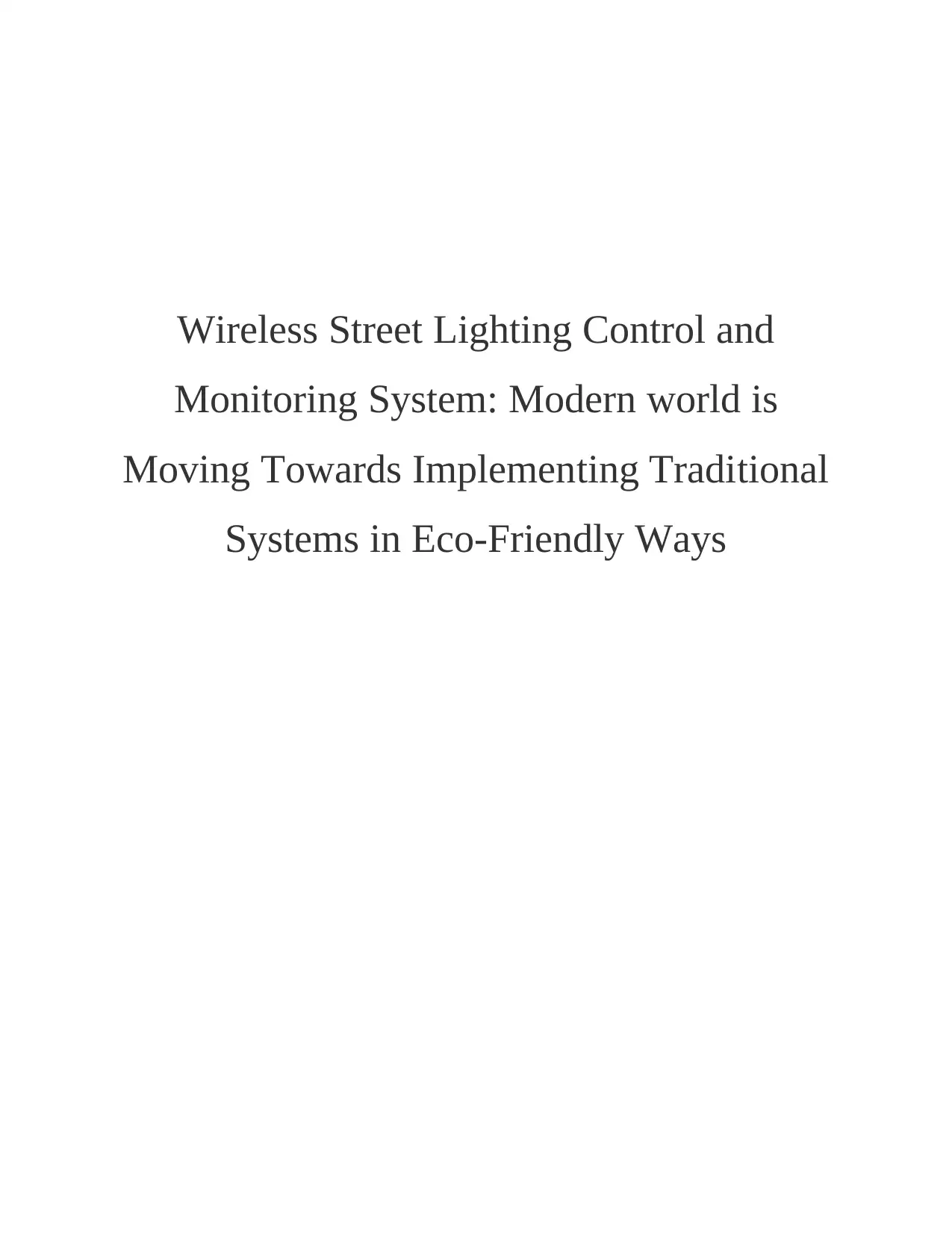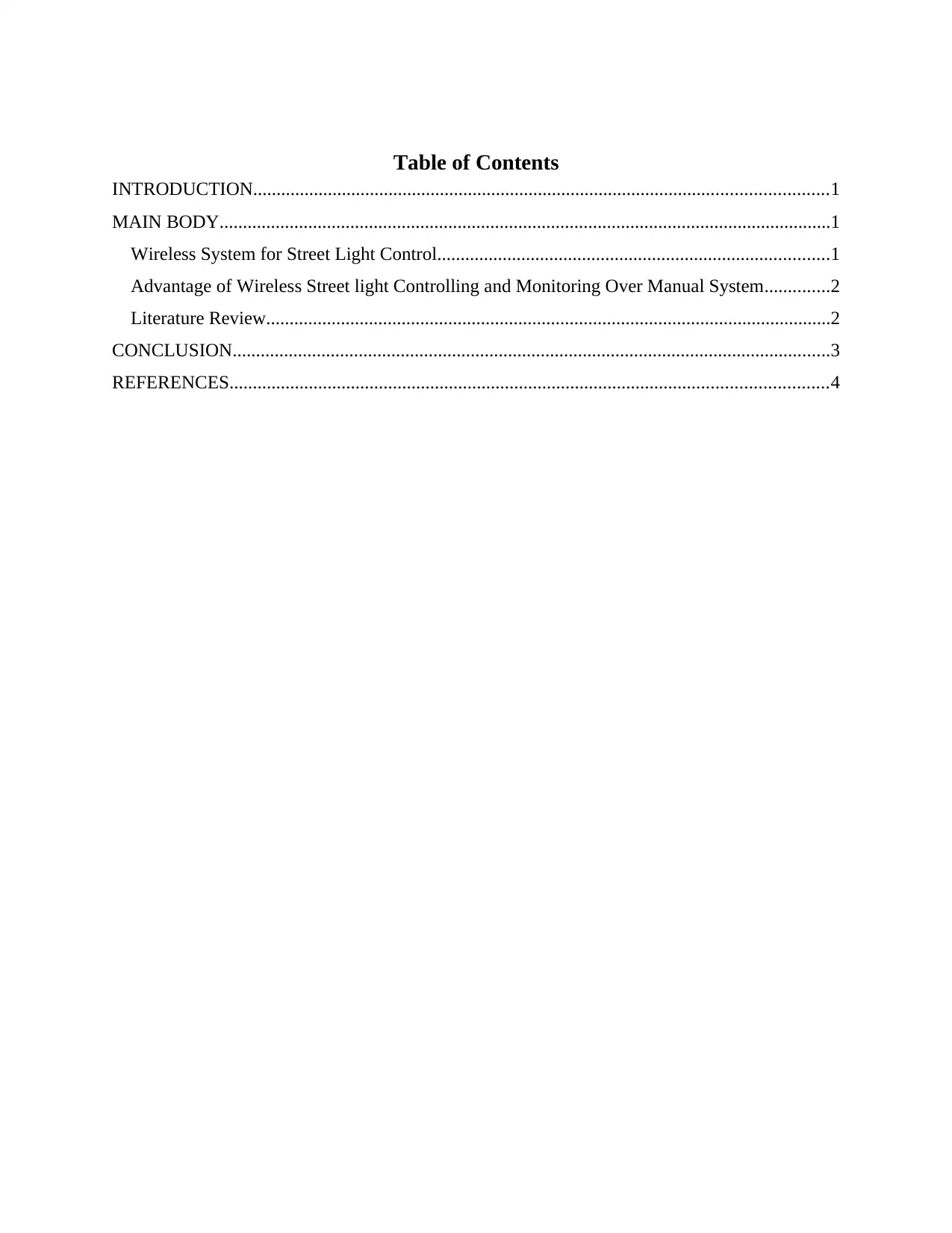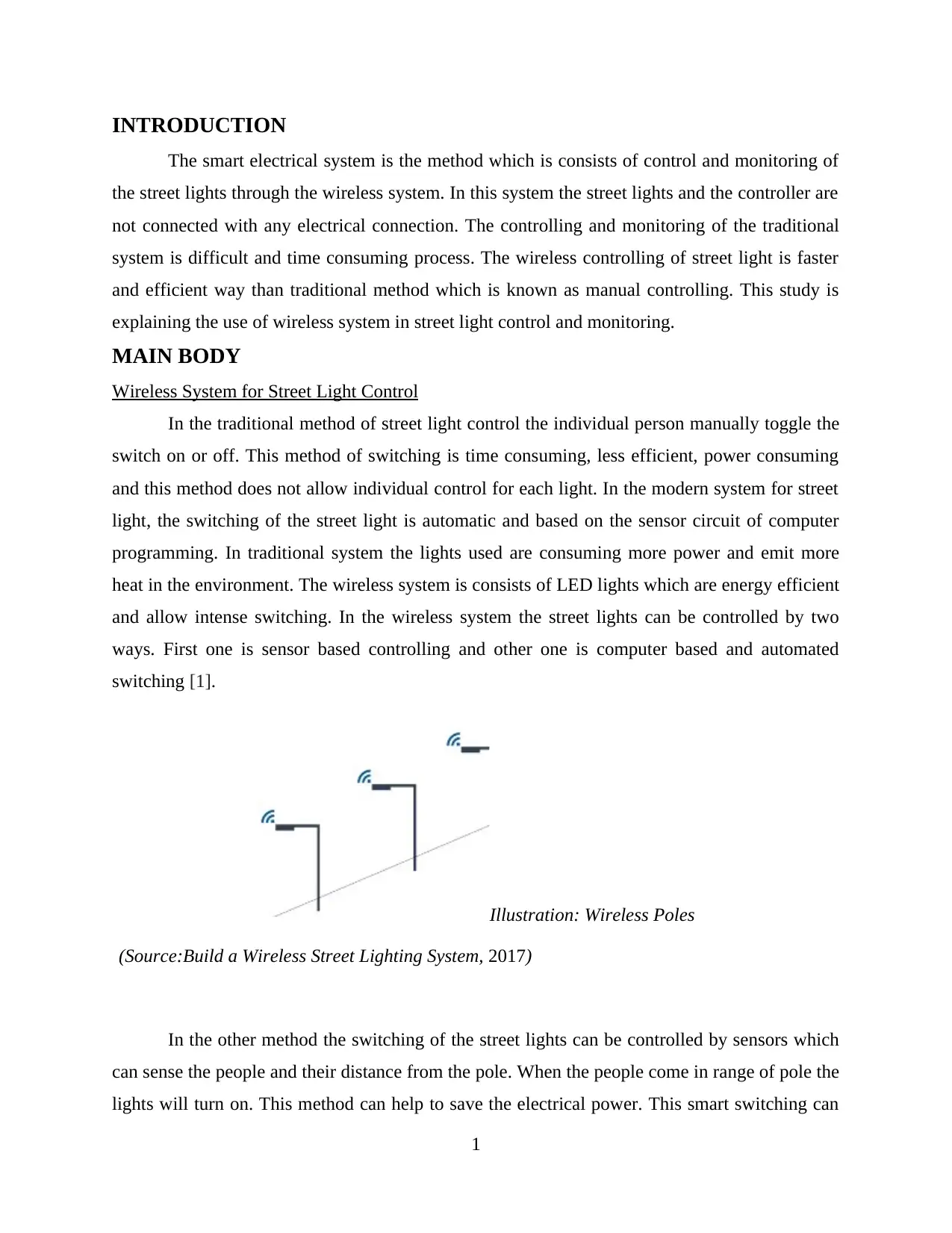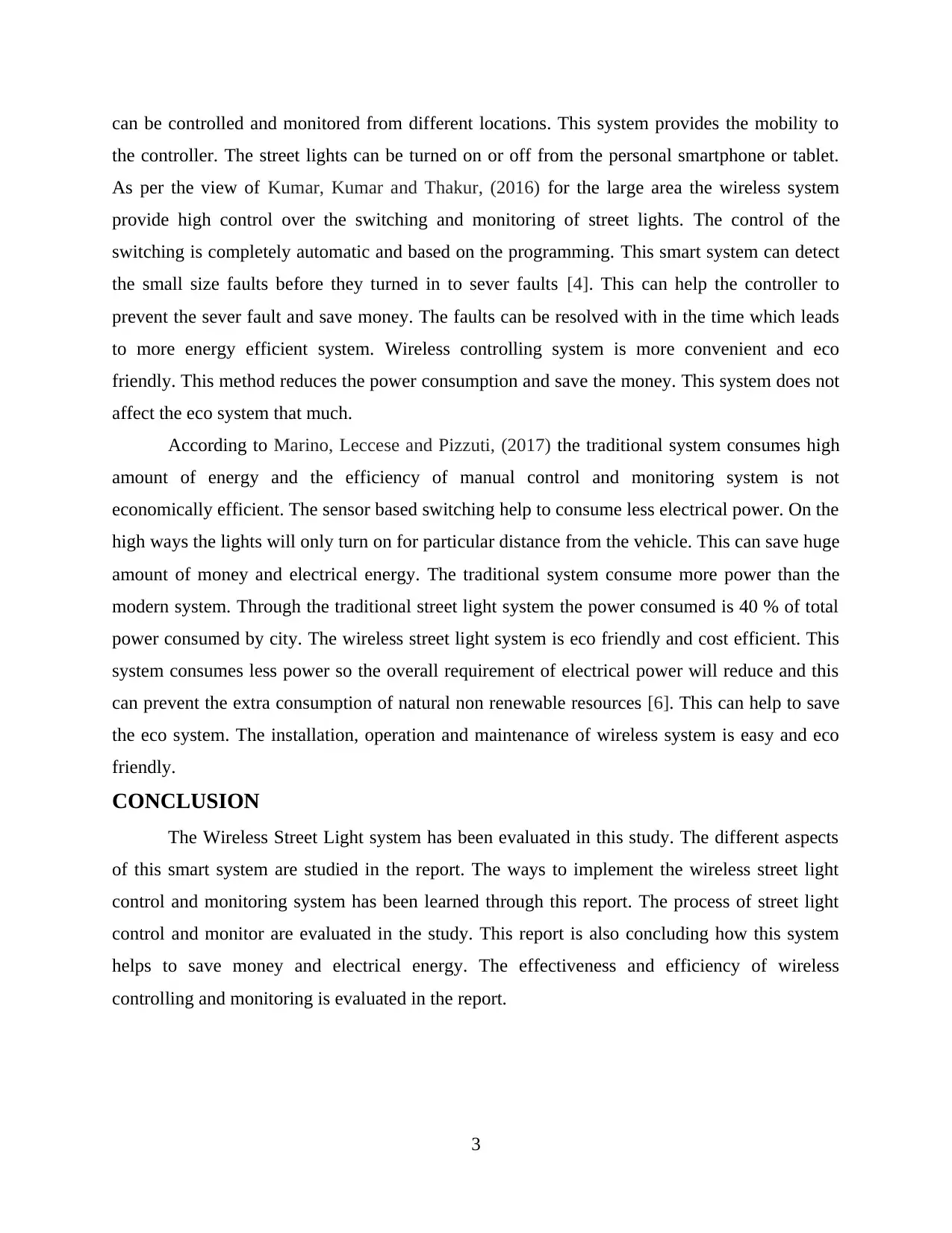Wireless Street Lighting Control and Monitoring System Analysis Report
VerifiedAdded on 2021/01/02
|6
|1514
|89
Report
AI Summary
This report provides a comprehensive overview of wireless street lighting control and monitoring systems. It begins with an introduction to smart electrical systems and the advantages of wireless control over traditional manual methods. The main body delves into the specifics of wireless street light control, including sensor-based and computer-based automated switching, highlighting the use of energy-efficient LED lights. It discusses the advantages of wireless systems, such as low power consumption, failure detection, and automatic control based on sunrise and sunset. The report includes a literature review, citing various sources that support the benefits of wireless street lighting in terms of energy and cost efficiency, remote control, and environmental impact. The conclusion summarizes the key findings, emphasizing the effectiveness and efficiency of wireless control and monitoring systems. The report also includes references to various books and journals used in the research.

Wireless Street Lighting Control and
Monitoring System: Modern world is
Moving Towards Implementing Traditional
Systems in Eco-Friendly Ways
Monitoring System: Modern world is
Moving Towards Implementing Traditional
Systems in Eco-Friendly Ways
Paraphrase This Document
Need a fresh take? Get an instant paraphrase of this document with our AI Paraphraser

Table of Contents
INTRODUCTION...........................................................................................................................1
MAIN BODY...................................................................................................................................1
Wireless System for Street Light Control....................................................................................1
Advantage of Wireless Street light Controlling and Monitoring Over Manual System..............2
Literature Review.........................................................................................................................2
CONCLUSION................................................................................................................................3
REFERENCES................................................................................................................................4
INTRODUCTION...........................................................................................................................1
MAIN BODY...................................................................................................................................1
Wireless System for Street Light Control....................................................................................1
Advantage of Wireless Street light Controlling and Monitoring Over Manual System..............2
Literature Review.........................................................................................................................2
CONCLUSION................................................................................................................................3
REFERENCES................................................................................................................................4

INTRODUCTION
The smart electrical system is the method which is consists of control and monitoring of
the street lights through the wireless system. In this system the street lights and the controller are
not connected with any electrical connection. The controlling and monitoring of the traditional
system is difficult and time consuming process. The wireless controlling of street light is faster
and efficient way than traditional method which is known as manual controlling. This study is
explaining the use of wireless system in street light control and monitoring.
MAIN BODY
Wireless System for Street Light Control
In the traditional method of street light control the individual person manually toggle the
switch on or off. This method of switching is time consuming, less efficient, power consuming
and this method does not allow individual control for each light. In the modern system for street
light, the switching of the street light is automatic and based on the sensor circuit of computer
programming. In traditional system the lights used are consuming more power and emit more
heat in the environment. The wireless system is consists of LED lights which are energy efficient
and allow intense switching. In the wireless system the street lights can be controlled by two
ways. First one is sensor based controlling and other one is computer based and automated
switching [1].
In the other method the switching of the street lights can be controlled by sensors which
can sense the people and their distance from the pole. When the people come in range of pole the
lights will turn on. This method can help to save the electrical power. This smart switching can
1
Illustration: Wireless Poles
(Source:Build a Wireless Street Lighting System, 2017)
The smart electrical system is the method which is consists of control and monitoring of
the street lights through the wireless system. In this system the street lights and the controller are
not connected with any electrical connection. The controlling and monitoring of the traditional
system is difficult and time consuming process. The wireless controlling of street light is faster
and efficient way than traditional method which is known as manual controlling. This study is
explaining the use of wireless system in street light control and monitoring.
MAIN BODY
Wireless System for Street Light Control
In the traditional method of street light control the individual person manually toggle the
switch on or off. This method of switching is time consuming, less efficient, power consuming
and this method does not allow individual control for each light. In the modern system for street
light, the switching of the street light is automatic and based on the sensor circuit of computer
programming. In traditional system the lights used are consuming more power and emit more
heat in the environment. The wireless system is consists of LED lights which are energy efficient
and allow intense switching. In the wireless system the street lights can be controlled by two
ways. First one is sensor based controlling and other one is computer based and automated
switching [1].
In the other method the switching of the street lights can be controlled by sensors which
can sense the people and their distance from the pole. When the people come in range of pole the
lights will turn on. This method can help to save the electrical power. This smart switching can
1
Illustration: Wireless Poles
(Source:Build a Wireless Street Lighting System, 2017)
⊘ This is a preview!⊘
Do you want full access?
Subscribe today to unlock all pages.

Trusted by 1+ million students worldwide

be used for the high-ways and local streets. In the wireless system each pole is connected with
the cloud computing or wireless network which can be controlled from large distance. The
system provide mobility to the controlling and monitoring operation. The street lights can be turn
on or off from mobile location [2]. This provide high controlling and monitoring in the system.
The errors in the system are visible in the wireless controlling. Each pole on the street is consists
of the smart system which calculates the different important measures which can make the
system more cost and energy efficient. This calculated measures are provided to the controlling
and monitoring. By this calculated data can help the server to find the error and failure in the
system. This information is saved for the each pole which provide more convenience to the
engineers to solve the fault. The wire less switching provide more control over the street light
and the failure detector system and real time information collection provide high monitoring of
the system [7].
Advantage of Wireless Street light Controlling and Monitoring Over Manual System
Low Power Consumption
The led lights are used in the modern system can be regulated or switched when no
people are around this can help to save 50% of electrical power. In the traditional method the
street lights are constantly runs and consume power which cause the extra cost.
Failure Detection
The failures can be detected on the centralized system. Through this to faults can be
detected before occurrence and this can improve the efficiency of system.
Automatic Control
The switching of lightning can be controlled automatically and this improves the lifetime
of the LEDs and the overall system effectiveness and efficiency improves [3]. The switching of
the street light is based on the sunrise and sunset in automated system this reduce the cost of
power by this effective switching.
Manual Control
The facility of manual control is also provided in this system and at the time of
emergency the local; people can turn on the street light.
Literature Review
The wireless system for street light system is performed using the wireless and cloud
computing. This system is more energy and cost efficient. In the wireless system the street lights
2
the cloud computing or wireless network which can be controlled from large distance. The
system provide mobility to the controlling and monitoring operation. The street lights can be turn
on or off from mobile location [2]. This provide high controlling and monitoring in the system.
The errors in the system are visible in the wireless controlling. Each pole on the street is consists
of the smart system which calculates the different important measures which can make the
system more cost and energy efficient. This calculated measures are provided to the controlling
and monitoring. By this calculated data can help the server to find the error and failure in the
system. This information is saved for the each pole which provide more convenience to the
engineers to solve the fault. The wire less switching provide more control over the street light
and the failure detector system and real time information collection provide high monitoring of
the system [7].
Advantage of Wireless Street light Controlling and Monitoring Over Manual System
Low Power Consumption
The led lights are used in the modern system can be regulated or switched when no
people are around this can help to save 50% of electrical power. In the traditional method the
street lights are constantly runs and consume power which cause the extra cost.
Failure Detection
The failures can be detected on the centralized system. Through this to faults can be
detected before occurrence and this can improve the efficiency of system.
Automatic Control
The switching of lightning can be controlled automatically and this improves the lifetime
of the LEDs and the overall system effectiveness and efficiency improves [3]. The switching of
the street light is based on the sunrise and sunset in automated system this reduce the cost of
power by this effective switching.
Manual Control
The facility of manual control is also provided in this system and at the time of
emergency the local; people can turn on the street light.
Literature Review
The wireless system for street light system is performed using the wireless and cloud
computing. This system is more energy and cost efficient. In the wireless system the street lights
2
Paraphrase This Document
Need a fresh take? Get an instant paraphrase of this document with our AI Paraphraser

can be controlled and monitored from different locations. This system provides the mobility to
the controller. The street lights can be turned on or off from the personal smartphone or tablet.
As per the view of Kumar, Kumar and Thakur, (2016) for the large area the wireless system
provide high control over the switching and monitoring of street lights. The control of the
switching is completely automatic and based on the programming. This smart system can detect
the small size faults before they turned in to sever faults [4]. This can help the controller to
prevent the sever fault and save money. The faults can be resolved with in the time which leads
to more energy efficient system. Wireless controlling system is more convenient and eco
friendly. This method reduces the power consumption and save the money. This system does not
affect the eco system that much.
According to Marino, Leccese and Pizzuti, (2017) the traditional system consumes high
amount of energy and the efficiency of manual control and monitoring system is not
economically efficient. The sensor based switching help to consume less electrical power. On the
high ways the lights will only turn on for particular distance from the vehicle. This can save huge
amount of money and electrical energy. The traditional system consume more power than the
modern system. Through the traditional street light system the power consumed is 40 % of total
power consumed by city. The wireless street light system is eco friendly and cost efficient. This
system consumes less power so the overall requirement of electrical power will reduce and this
can prevent the extra consumption of natural non renewable resources [6]. This can help to save
the eco system. The installation, operation and maintenance of wireless system is easy and eco
friendly.
CONCLUSION
The Wireless Street Light system has been evaluated in this study. The different aspects
of this smart system are studied in the report. The ways to implement the wireless street light
control and monitoring system has been learned through this report. The process of street light
control and monitor are evaluated in the study. This report is also concluding how this system
helps to save money and electrical energy. The effectiveness and efficiency of wireless
controlling and monitoring is evaluated in the report.
3
the controller. The street lights can be turned on or off from the personal smartphone or tablet.
As per the view of Kumar, Kumar and Thakur, (2016) for the large area the wireless system
provide high control over the switching and monitoring of street lights. The control of the
switching is completely automatic and based on the programming. This smart system can detect
the small size faults before they turned in to sever faults [4]. This can help the controller to
prevent the sever fault and save money. The faults can be resolved with in the time which leads
to more energy efficient system. Wireless controlling system is more convenient and eco
friendly. This method reduces the power consumption and save the money. This system does not
affect the eco system that much.
According to Marino, Leccese and Pizzuti, (2017) the traditional system consumes high
amount of energy and the efficiency of manual control and monitoring system is not
economically efficient. The sensor based switching help to consume less electrical power. On the
high ways the lights will only turn on for particular distance from the vehicle. This can save huge
amount of money and electrical energy. The traditional system consume more power than the
modern system. Through the traditional street light system the power consumed is 40 % of total
power consumed by city. The wireless street light system is eco friendly and cost efficient. This
system consumes less power so the overall requirement of electrical power will reduce and this
can prevent the extra consumption of natural non renewable resources [6]. This can help to save
the eco system. The installation, operation and maintenance of wireless system is easy and eco
friendly.
CONCLUSION
The Wireless Street Light system has been evaluated in this study. The different aspects
of this smart system are studied in the report. The ways to implement the wireless street light
control and monitoring system has been learned through this report. The process of street light
control and monitor are evaluated in the study. This report is also concluding how this system
helps to save money and electrical energy. The effectiveness and efficiency of wireless
controlling and monitoring is evaluated in the report.
3

REFERENCES
Books and Journals
[1].Bellido-Outeiriño, F., and et. al., 2016. Streetlight control system based on wireless
communication over DALI protocol. Sensors. 16(5). p.597.
[2].Galindo, J.A. and Caya, M.V., 2018, November. Development of Street Lighting System
with Object Detection. In 2018 IEEE 10th International Conference on Humanoid,
Nanotechnology, Information Technology, Communication and Control, Environment and
Management (HNICEM) (pp. 1-5). IEEE.
[3].Kaleem, Z., Yoon, T.M. and Lee, C., 2016. Energy efficient outdoor light monitoring and
control architecture using embedded system. IEEE Embedded Systems Letters. 8(1). pp.18-
21.
[4].Kumar, M., Kumar, R. and Thakur, R., 2016. Zigbee Based Smart Street Light Control
System Using Lab VIEW. International Journal of Innovative Research in Science,
Engineering and Technology. 5(4).
[5].Malhotra, S. and Kumar, V., 2016. Smart Street Lighting System: An Energy Efficient
Approach. International Journal of Science and Research (IJSR) ISSN, pp.2319-7064.
[6].Marino, F., Leccese, F. and Pizzuti, S., 2017. Adaptive street lighting predictive
control. Energy Procedia. 111. pp.790-799.
[7].Sjöberg, I., Gidén Hember, A. and Wallerström, C., 2017. Smart street lighting: The
advantages of LED street lighting and a smart control system in Uppsala municipality.
Online
Build a Wireless Street Lighting System, 2017. [Online]. Available through :
<https://www.thingsquare.com/blog/articles/smart-wireless-led-street-lighting/>.
4
Books and Journals
[1].Bellido-Outeiriño, F., and et. al., 2016. Streetlight control system based on wireless
communication over DALI protocol. Sensors. 16(5). p.597.
[2].Galindo, J.A. and Caya, M.V., 2018, November. Development of Street Lighting System
with Object Detection. In 2018 IEEE 10th International Conference on Humanoid,
Nanotechnology, Information Technology, Communication and Control, Environment and
Management (HNICEM) (pp. 1-5). IEEE.
[3].Kaleem, Z., Yoon, T.M. and Lee, C., 2016. Energy efficient outdoor light monitoring and
control architecture using embedded system. IEEE Embedded Systems Letters. 8(1). pp.18-
21.
[4].Kumar, M., Kumar, R. and Thakur, R., 2016. Zigbee Based Smart Street Light Control
System Using Lab VIEW. International Journal of Innovative Research in Science,
Engineering and Technology. 5(4).
[5].Malhotra, S. and Kumar, V., 2016. Smart Street Lighting System: An Energy Efficient
Approach. International Journal of Science and Research (IJSR) ISSN, pp.2319-7064.
[6].Marino, F., Leccese, F. and Pizzuti, S., 2017. Adaptive street lighting predictive
control. Energy Procedia. 111. pp.790-799.
[7].Sjöberg, I., Gidén Hember, A. and Wallerström, C., 2017. Smart street lighting: The
advantages of LED street lighting and a smart control system in Uppsala municipality.
Online
Build a Wireless Street Lighting System, 2017. [Online]. Available through :
<https://www.thingsquare.com/blog/articles/smart-wireless-led-street-lighting/>.
4
⊘ This is a preview!⊘
Do you want full access?
Subscribe today to unlock all pages.

Trusted by 1+ million students worldwide
1 out of 6
Related Documents
Your All-in-One AI-Powered Toolkit for Academic Success.
+13062052269
info@desklib.com
Available 24*7 on WhatsApp / Email
![[object Object]](/_next/static/media/star-bottom.7253800d.svg)
Unlock your academic potential
Copyright © 2020–2025 A2Z Services. All Rights Reserved. Developed and managed by ZUCOL.




